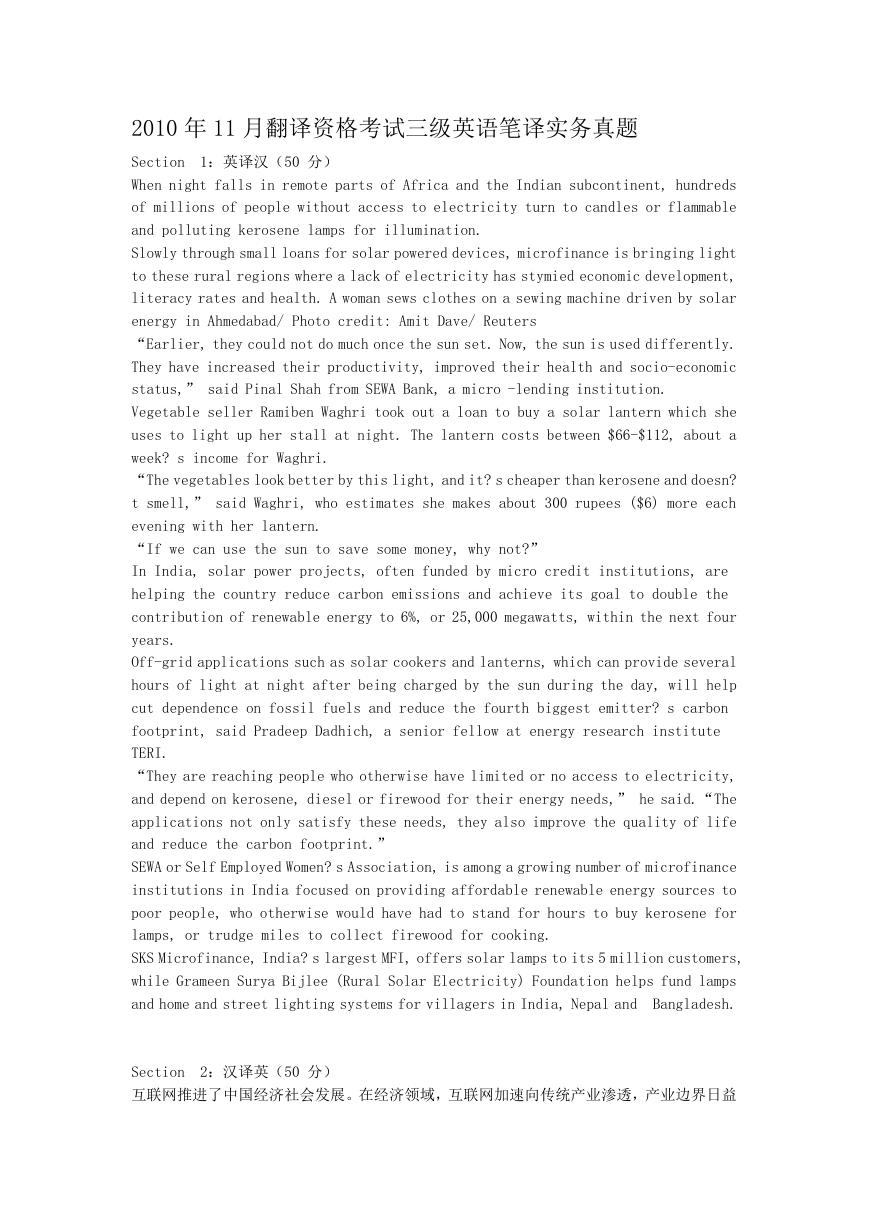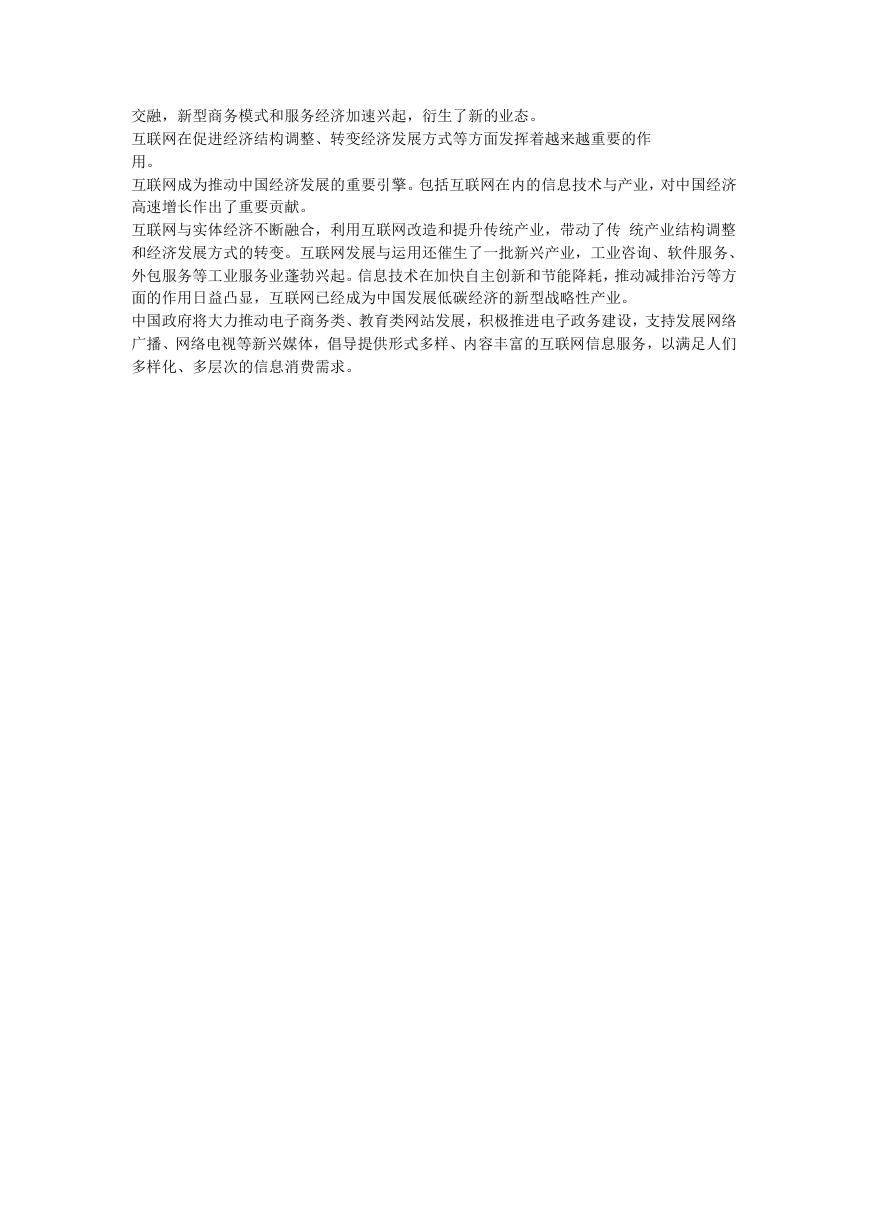2010 年 11 月翻译资格考试三级英语笔译实务真题
1:英译汉(50 分)
Section
When night falls in remote parts of Africa and the Indian subcontinent, hundreds
of millions of people without access to electricity turn to candles or flammable
and polluting kerosene lamps for illumination.
Slowly through small loans for solar powered devices, microfinance is bringing light
to these rural regions where a lack of electricity has stymied economic development,
literacy rates and health. A woman sews clothes on a sewing machine driven by solar
energy in Ahmedabad/ Photo credit: Amit Dave/ Reuters
“Earlier, they could not do much once the sun set. Now, the sun is used differently.
They have increased their productivity, improved their health and socio-economic
status,” said Pinal Shah from SEWA Bank, a micro -lending institution.
Vegetable seller Ramiben Waghri took out a loan to buy a solar lantern which she
uses to light up her stall at night. The lantern costs between $66-$112, about a
week? s income for Waghri.
“The vegetables look better by this light, and it? s cheaper than kerosene and doesn?
t smell,” said Waghri, who estimates she makes about 300 rupees ($6) more each
evening with her lantern.
“If we can use the sun to save some money, why not?”
In India, solar power projects, often funded by micro credit institutions, are
helping the country reduce carbon emissions and achieve its goal to double the
contribution of renewable energy to 6%, or 25,000 megawatts, within the next four
years.
Off-grid applications such as solar cookers and lanterns, which can provide several
hours of light at night after being charged by the sun during the day, will help
cut dependence on fossil fuels and reduce the fourth biggest emitter? s carbon
footprint, said Pradeep Dadhich, a senior fellow at energy research institute
TERI.
“They are reaching people who otherwise have limited or no access to electricity,
and depend on kerosene, diesel or firewood for their energy needs,” he said.“The
applications not only satisfy these needs, they also improve the quality of life
and reduce the carbon footprint.”
SEWA or Self Employed Women? s Association, is among a growing number of microfinance
institutions in India focused on providing affordable renewable energy sources to
poor people, who otherwise would have had to stand for hours to buy kerosene for
lamps, or trudge miles to collect firewood for cooking.
SKS Microfinance, India? s largest MFI, offers solar lamps to its 5 million customers,
while Grameen Surya Bijlee (Rural Solar Electricity) Foundation helps fund lamps
Bangladesh.
and home and street lighting systems for villagers in India, Nepal and
Section
互联网推进了中国经济社会发展。在经济领域,互联网加速向传统产业渗透,产业边界日益
2:汉译英(50 分)
�
交融,新型商务模式和服务经济加速兴起,衍生了新的业态。
互联网在促进经济结构调整、转变经济发展方式等方面发挥着越来越重要的作
用。
互联网成为推动中国经济发展的重要引擎。包括互联网在内的信息技术与产业,对中国经济
高速增长作出了重要贡献。
互联网与实体经济不断融合,利用互联网改造和提升传统产业,带动了传 统产业结构调整
和经济发展方式的转变。互联网发展与运用还催生了一批新兴产业,工业咨询、软件服务、
外包服务等工业服务业蓬勃兴起。信息技术在加快自主创新和节能降耗,推动减排治污等方
面的作用日益凸显,互联网已经成为中国发展低碳经济的新型战略性产业。
中国政府将大力推动电子商务类、教育类网站发展,积极推进电子政务建设,支持发展网络
广播、网络电视等新兴媒体,倡导提供形式多样、内容丰富的互联网信息服务,以满足人们
多样化、多层次的信息消费需求。
�




 2023年江西萍乡中考道德与法治真题及答案.doc
2023年江西萍乡中考道德与法治真题及答案.doc 2012年重庆南川中考生物真题及答案.doc
2012年重庆南川中考生物真题及答案.doc 2013年江西师范大学地理学综合及文艺理论基础考研真题.doc
2013年江西师范大学地理学综合及文艺理论基础考研真题.doc 2020年四川甘孜小升初语文真题及答案I卷.doc
2020年四川甘孜小升初语文真题及答案I卷.doc 2020年注册岩土工程师专业基础考试真题及答案.doc
2020年注册岩土工程师专业基础考试真题及答案.doc 2023-2024学年福建省厦门市九年级上学期数学月考试题及答案.doc
2023-2024学年福建省厦门市九年级上学期数学月考试题及答案.doc 2021-2022学年辽宁省沈阳市大东区九年级上学期语文期末试题及答案.doc
2021-2022学年辽宁省沈阳市大东区九年级上学期语文期末试题及答案.doc 2022-2023学年北京东城区初三第一学期物理期末试卷及答案.doc
2022-2023学年北京东城区初三第一学期物理期末试卷及答案.doc 2018上半年江西教师资格初中地理学科知识与教学能力真题及答案.doc
2018上半年江西教师资格初中地理学科知识与教学能力真题及答案.doc 2012年河北国家公务员申论考试真题及答案-省级.doc
2012年河北国家公务员申论考试真题及答案-省级.doc 2020-2021学年江苏省扬州市江都区邵樊片九年级上学期数学第一次质量检测试题及答案.doc
2020-2021学年江苏省扬州市江都区邵樊片九年级上学期数学第一次质量检测试题及答案.doc 2022下半年黑龙江教师资格证中学综合素质真题及答案.doc
2022下半年黑龙江教师资格证中学综合素质真题及答案.doc